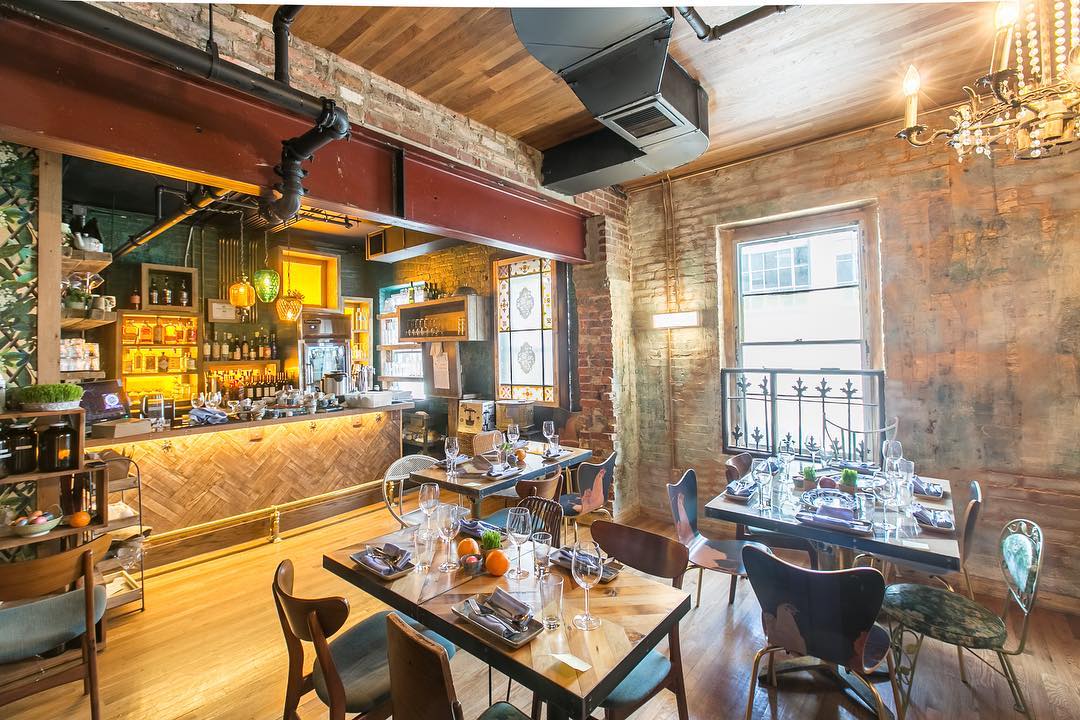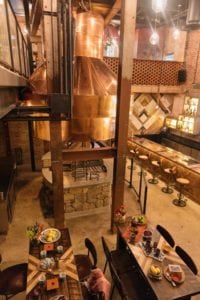Convivial Design Is on Display at D.C.’s Acclaimed Maydan

Photo Caption: Only cold food is prepared in the back kitchen at Maydan; everything warm, including house-made flatbread, is cooked on the large, central hearth. Daniel Schwartz
Skift Take
Working with the right architect gave Maydan owner Rose Previte, license to create her ideal dining room centered around a central hearth with an open flame.
Rose Previte, owner of Washington, D.C.’s Maydan, describes her restaurant as an ‘organic, feelings-based project,” admitting that her approach to opening the place may have been unconventional. Given the restaurant’s reception, though, going with her gut isn’t something Previte really needs to justify.
Critically lauded many times over (including its most recent: near top placement on Bon Appétit’s Best New Restaurants list) since it opened last November, Maydan has been warmly welcomed — something Previte hopes she, too, can do for everyone who steps foot in her restaurant. This goal is, both figuratively and literally, accomplished through Maydan’s physical design.
Maydan is located in D.C.’s trendy Shaw neighborhood, more specifically in its historic Manhattan Laundry Building, a 130-year-old space that formerly housed (unsurprisingly) a commercial laundry in the early 20th century, and a printing plant before that. Originally, the space functioned as a service center and storage facility for street cars, hence its enormous scale; in recent years, a WeWork and La Colombe Coffee Roasters have opened.
A developer approached Previte with the space after taking note of the success of her first restaurant, Compass Rose, but Previte was initially skeptical. Upon visiting the space, though, she knew it had to be hers. When she learned through a visit to her local library that the building’s permit was issued on her birthday, there was absolutely no going back.
The concept of a traditional “maydan,” a word with Persian roots whose various spellings all translate to some version of a central “gathering place,” first came across Previte’s radar while she was visiting Ukraine’s Independence Square. There, she recognized the value of creating “an acceptable place to meet people in public” and aspired to do so in her new space. Her restaurant would have an open kitchen in the center of the space, where the amber glow of a fire would greet diners immediately upon entry.
Her vision was to “make everyone walk through ‘the square,’ by the fire, past people waiting by barstools, to encourage instant human contact.” Mission accomplished. The open design of her restaurant yields a convivial atmosphere that lends itself to a sense of community and togetherness. Those seeking privacy may want to go elsewhere: Previte admits the “Obamas have come twice, there was nowhere I could hide them.”

The central hearth at D.C.’s Maydan restaurant
The 20-foot ceilings of the original space now work to Maydan’s advantage. Previte initially dreamt of having an outdoor space, but since that wasn’t feasible, the next best option was to connect her copper-domed grill to the outside, using the existing hood space in the center of the room. Maydan’s central hearth is, inarguably, its focal point, as movement around it isn’t only encouraged, but necessary.
The approximately 3,000 square foot restaurant seats 100 people at any given time, with 60 on the mezzanine that overlook the central kitchen. The grill isn’t just the visual focus; it also determines the menu. There’s no stove at Maydan. Instead, menu items inspired by Previte and her team’s travels last summer through Morocco, Tunisia, Turkey, Georgia, and Lebanon are grilled to honor the simple techniques, pure flavors, history, and quality of those countries’ cuisines. House-made flatbread is baked in the clay pot ovens built into the hearth, and every warm item on the menu spends at least some time in the open fire.
Only cold food comes from the back, and the expo line is located adjacent to the fire. Previte’s understanding of how space is, and should be, used in a restaurant is informed by her experience working as a bartender and server for more than a decade: “Going into designing a place from scratch, you have a good understanding of where people stand and how a space is used from being in the industry, that an architect may not understand.”
But an architect does understand code compliance. Previte acknowledged that her insistence on having an open fire in the center of her restaurant was a huge design risk that she was only able to take by working with architect Michelle Bove, whose D.C.-based firm designCase helped prevent Previte from having to sacrifice her aesthetic for code’s sake. “A lot of estrogen” is behind the space’s design in other ways, too.
New York-based artist, and Previte’s former roommate, Martina Crivella, helped with elements of the buildout, including custom wood inlays, fabric-covered walls, ornate tilework, and custom wallpaper. Los Angeles-based artist (and former Compass Rose employee) Janelle Whisenant painted a mural and hand-etched the stair risers. Previte, who admits to being “obsessed with old things”, also personally sourced quite a few of Maydan’s aesthetic elements.
She picks up whatever she can when she travels, including, in Maydan’s case, vintage lighting from the Fairfax Flea Market in LA, gutted Brownstone pieces like doors and windows from Big Reuse in Gowanus, Brooklyn, metal bread plates from Oman, tiles and textiles from Lebanon and Tunisia, and fence pieces from an antiques store in Maryland she used as iron window bars, leftover from Compass Rose. Because “old things come with energy that feels good in the space”, she doesn’t like to use a lot of new materials — “that’s why it feels so warm” at Maydan. It’s one reason, anyway.
Skift Table contributor Ally Spier is a Brooklyn-based writer and designer who studied ergonomics at Cornell, and architecture at Pratt. Her background in design informs her love of food and travel… and vice versa.

The travel industry's top event returns this fall.
September 16-18, 2025 - NEW YORK CITY
